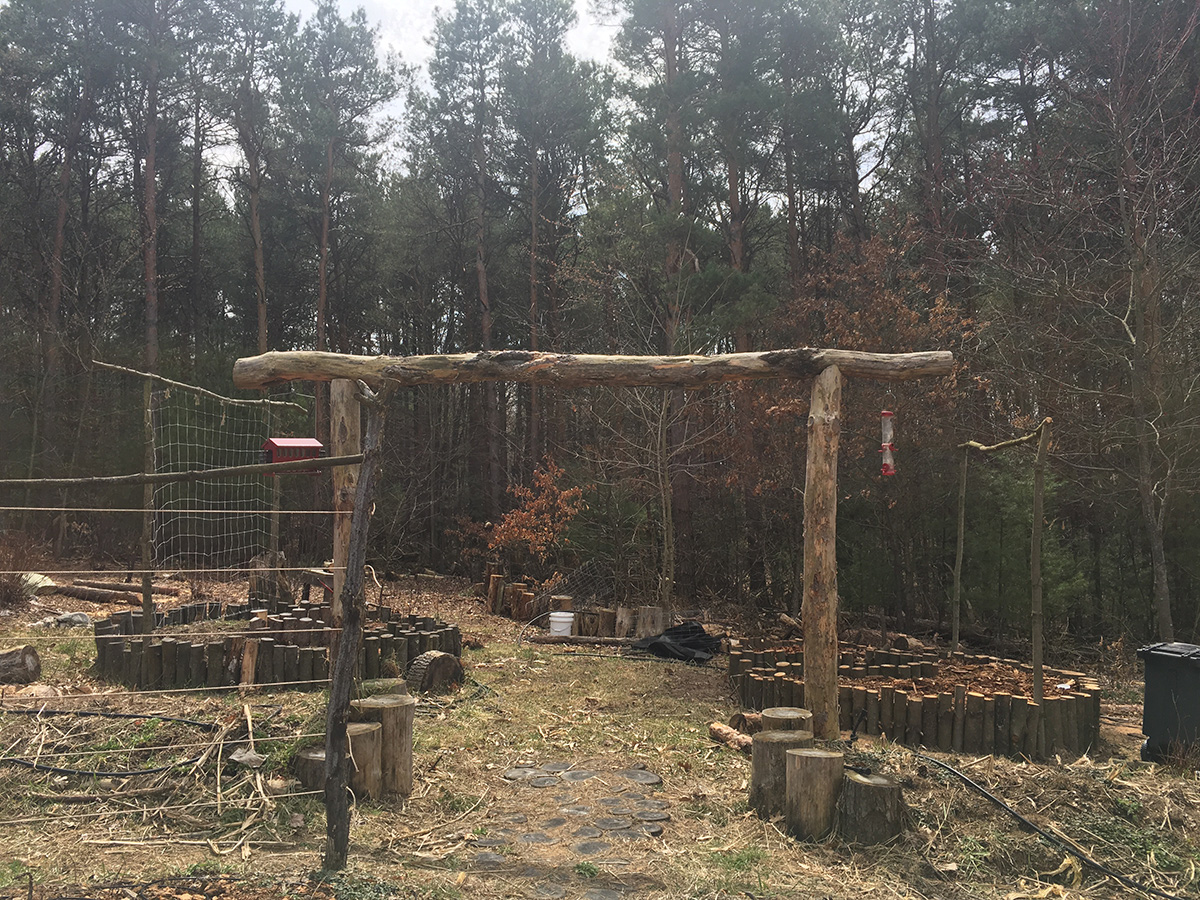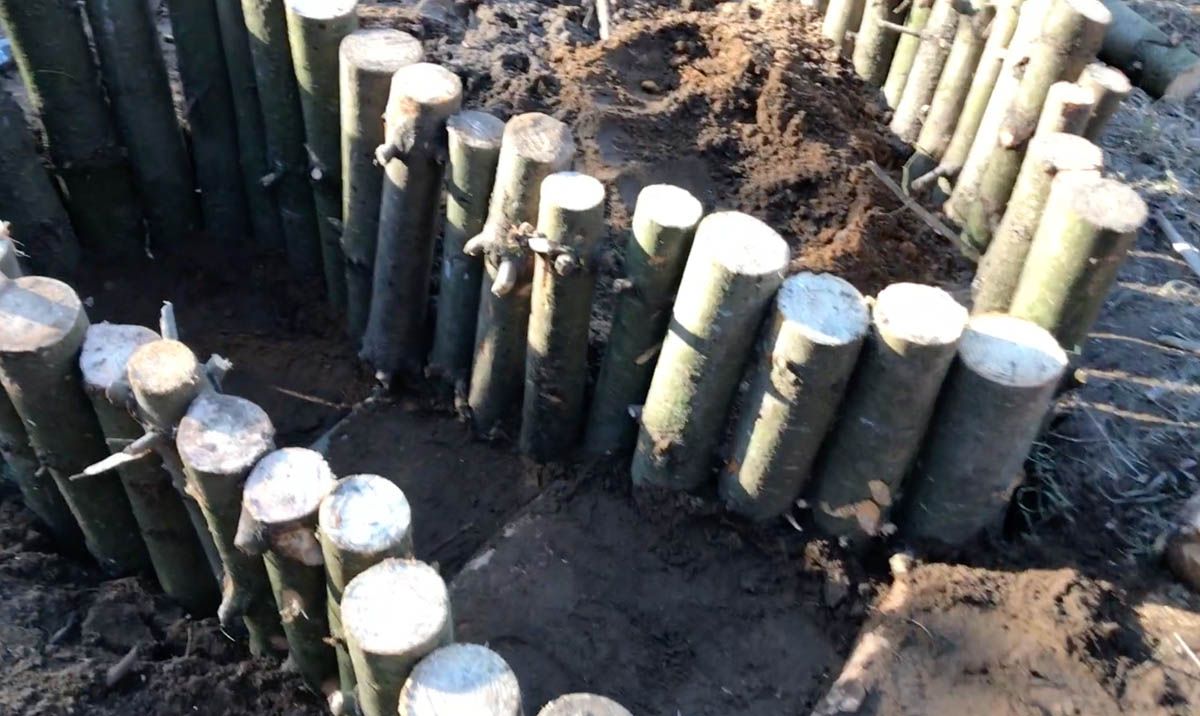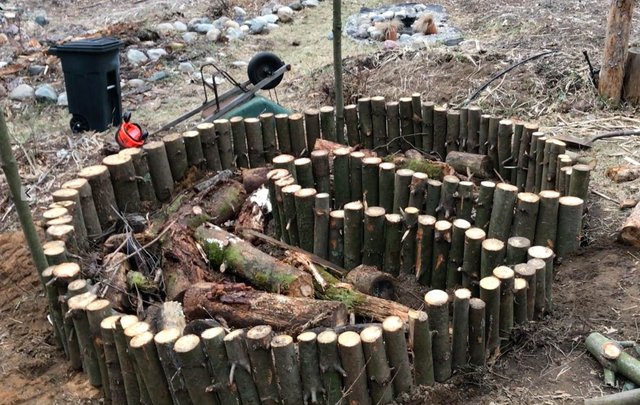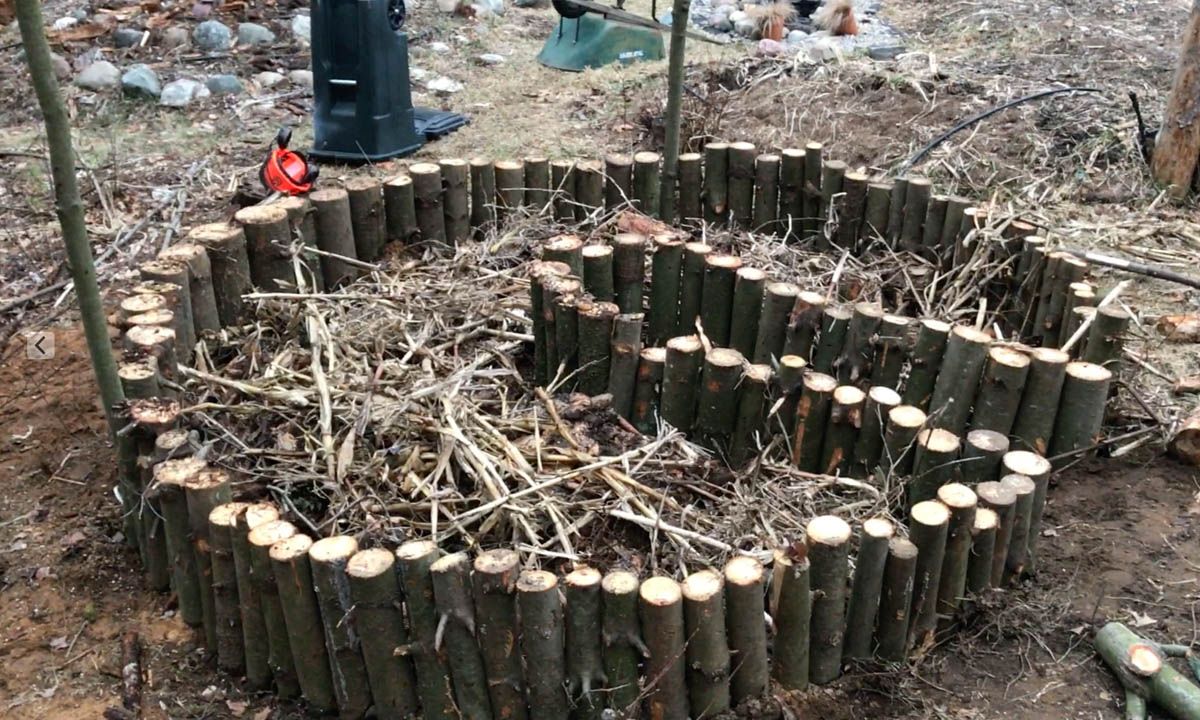Building a raised bed, hugelkultur keyhole garden

I wanted to see what would happen if I combined all of the classic permaculture methods into one beastly raised bed. But I wanted to do it for next to nothing, so I had to scavenge what was available on my property. The only thing I purchased was the netting for the trellis. I combined hugelkultur, sheet mulching, and a keyhole garden into one. Because I used hugelkultur to fill some of the bed, I didn't need to purchase any garden soil to raise it. The keyhole allowed me to access the center while optimizing the total square feet for growing, and because I sunk the keyhole down, I don't have to bend over to reach anything in the bed.
This was the second one I built. The first turned out to be much more of an undertaking than I thought it would. Cutting up all the pieces of wood for the walls and placing them was tedious and time consuming. I promised myself I wouldn't do again, but I had to do another one to complete the symmetry. The first one I didn't sheet mulch or burry the wood as deeply, and the soil turned out too shallow and became weedy. This time I did it right, and had much better success.

I started by outlining a perfect circle 10’ in diameter. It’s easy to do, just pound a stake into the ground, loop a rope around it, make another loop in the rope 5’ out. Then just place a stick through the outside loop and circle around the center stake marking the ground with your stick.
Once I had the circle marked, I dug it out about 1 foot making sure to place all of the topsoil on a tarp for later use. You’ll need at least a 10’ x 10’ tarp.

I found where I wanted the keyhole and dug about another 1-1.5’ deep path to the center, with the eye of the keyhole about 3’ diameter circle. I created a few steps down to the center by digging it 8 inches deeper every foot or so, and placing a piece of wood to retain the soil from the upper step. This is how it looked once the walls were in place.

Cutting and placing the walls of the bed was the most time-consuming part. I had a few areas in my forest that needed some thinning, young pines were crowding some lovely maples. This seemed like a good way to use some of the excess wood that I cleared. I cut about 20 trees, ranging from 3-8” in diameter, into 24-36” pieces and stacked them around the outside of the circle to form the border of the bed. Make sure to cut your pieces for lower keyhole about a foot taller.
For the trellis, I simply cut three 12’ poles from 2-3” diameter maple trees, dug two of them into the ground about 2-3’ deep, and nailed one horizontally onto the tops of the vertical poles.
I filled the bottom with partially rotted wood, and then throw as much vegetable scraps as I had available. I had a garbage bin filled from over the winter. On top of that I threw down leaves and cornstalks from the previous year. Finally, I filled it all back in. I added a sprinkling of wood ash and a bit of pelleted manure I received from a friend and mixed it into the top few inches.


At this point, you have highly disturbed soil that will have tons of weeds ready to germinate. So I placed down a layer of cardboard and mulched with well-rotted pine and oak that had been laying around in my forest decomposing for years.


Finally, I planted the bed! The tomatoes and onions absolutely loved it! The cabbages were demolished by slugs, apparently, the mulch was an attractant for them. I would advise staying away from brassicas the first year or two. Any vegetable that likes woody soils would do great. Tomatoes, peppers, cucumbers, onions, and garlic are what I’ll stick to for now.

The growth was amazing! My tomatoes loved it and grew ridiculously fast. No weeds besides a few grass rhizomes sneaking through here and there. The onions did really well also. It didn’t need much watering with the rotted wood underneath, and mulch up top absorbing and wicking moisture.
the trellis is about 7.5' tall from the bed




With that said, this was a ton of work. Totally not worth it if trying to maximize your efficiency. But it was a fun project and added variety to my growing options. I’m glad I did it, but I won’t be making any more, two is enough.
Having a forest of your own is a complete game changer! Looking at the photos, I caught myself thinking - whoa, that's a lot of wood, how much will that cost, how will I transport it to the garden... :)
So while we're on a small village plot, we're actively creating a wooded section on the north fence and the north-western as a buffer for bad weather that's usually coming from that direction.
This far we've only harvested a few dozen small black locust as poles to use in the garden and a few larger dead trees (mulberry, walnut, elm) for burning in the summer evenings, but things are looking up.
Yeah, with a forest surrounded me I have so many resources at my disposal. But sun is a bit harder to come by. So I usually have excess wood from opening some areas up for new garden beds, herbs, shrubs, and fruit trees. If you have black locusts you are in luck! They grow fast as pines and won’t rot for 100 years. They also regrow very fast and are perfect for coppicing.
I would just do a similar approach with stone, brick, or whatever materials you have available if you want to do something similar. You can even just do a keyhole without raising it much, just mounding it a bit.
Right, black locust is common around here. We have some on the fence with our neighbor and have started hundred of seedlings this year for future planting around in the "wild", as well as at suitable places in the yars. They are also great forage for the bees, and we also eat the flowers and make a elderberry/black locust flower syrup (cordial?). So plenty of uses + it's a nitrogen fixer!
That would be great for garden in a city setting as well.
Yeah. It’s compact and serves a lot of functions. It would be great for small backyards as long as you can source the materials, it’s pretty cheap. It could be done with brick or stone and look really nice. The wood borders will eventually rot, but should serve their purpose for 5-10 years, at which point I’ll use them to add organic matter to the bed which would be a smaller mound by that time with the settling.
It's not only functional but an aesthetic design when you combined hugelkultur, sheet mulching, and a keyhole garden into one. I love it! But I agree, it's so labor intensive. Maybe it can be a fun project for apprentices and wwoofers. Just a thought. ;-) Well done!
Haha, make the free help do all the labor, perfect! In all seriousness though, it would be a good learning experience for newbs. There would be a lot of teaching opportunities, learn how to fell trees on a small scale and use a chainsaw, learn how to setup a proper hugelkultur bed, sheet mulch, build a trellis, and scavenge for materials in a forest.
Haha ... it's a win/win. You get free help and they get the experience!
I would love to know how you fell trees on a small scale. Thanks
I just meant felling small softwood trees, 4” - 8” in diameter. Best place to learn how to make a notch and back cut. Then you can move up to larger hardwoods once you have that down. The largest hardwood I’ve fell was around 24” diameter 50-60’ tall.
This turned out beautifully! Really well done. I especially love the shape. Has it been long enough to notice any settling?
There was lot of settling, usually the most the first year. About 6” or more from when it was established. With that in mind, I would probably fill it all the way to the very top and somewhat higher in the centers initially. I’m going to do another layer of mulch, probably leaves next year. Good question, thanks for mentioning that.
the addition of the keyhole is brilliant; i'll hopefully be trying this on the property this spring - thanks for the inspiration!
That's good work.
I experimented with hugelkultur on a couple of beds this past year. Worked quite well although wasn't so good for potatoes.
We have grown potatoes on hugelkultur with good results. Just make sure you have plenty of soil to heap on top once they grow taller. Read that you should add about 6 inches of soil to prevent greening and get a good crop. So we added a foot. :)
I have made a back to eden/ deep mulch orchard and thought about making part of it huglculture for some herbs or something! Definitely worth the effort from what I have heard!
Just get a cow and you will have fertilizant for all your land. The model looks very nice tho :).
Thanks! Cows require a lot of infrastructure, grasslands and costs to keep alive. I live in a forest that’s zoned residential, so it’s not really practical to own a cow. I have plenty of fertilizer available in multiple forms, wood ash and urine provide any minerals and nitrogen that are needed.
I was unaware of the decoration of this city. And first I saw such a garden in my life. The whole eye was over. Friend is such a scene if we can see us. @theferalone
That looks brilliant. We have been growing with hugelkultur for a few years now and have had many successes. We have read about keyhole gardens but not built any. Yet! Very keen to try and combine the two now. Really like the look of the wood walls. Our main problems with our garden is the lack of mulching availability as we are loath to spend money on wood chips. And slugs. Urrg. A nightly routine of hunting for them with a torch and chopsticks gets a bit tedious but the chickens sure do love them for breakfast. The hight of your tomatoes is impressive. Kudos to you good sir!
Leaves are the best mulch if you have them available. Wood chips are overrated IMO. You don’t see 6-8 inches of wood chips or rotted wood covering any natural areas. You see hay and leaves. Of course slugs love them, but so do toads, frogs, and snakes, which usually keep my slug problem in check. But since this was a new bed, there weren’t too many here, they were hanging out in my older beds, and kept all the slugs at a level I could live with.
We recently had to move property so have started again from scratch. Slowly turning the useless lawn into a food factory. But there are only two fully grown trees on the property so not much in the way of leaves dropping. Also, we live in a volcanic region so under about an inch or two (at best) of topsoil it's just pumice. Great for drainage. The hugel beds definitely help. This afternoon I did a lot of Tomato work and ended up with lots of foliage. Have put it across a new bed of Peppers to try and keep some moisture in. We also tend to put banana skins out on beds to act as some kind of mulch. Suspect that this year will be quite hit and miss with a lot of crops. It's shaping up to be a very hot summer.